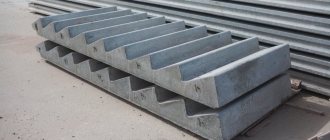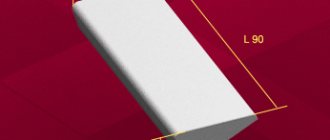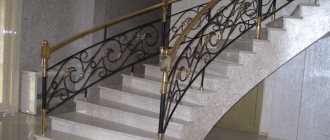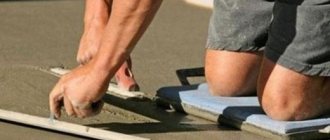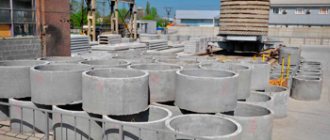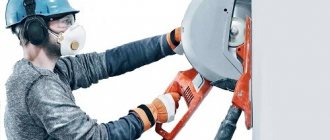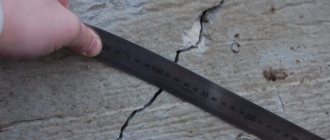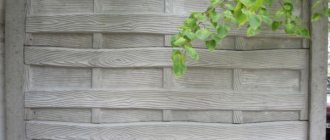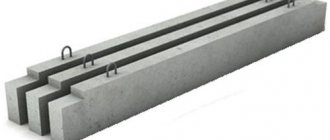What types of reinforced concrete staircases are there? What are their dimensions? How to make a reinforced concrete staircase with your own hands? We will try to answer these and many other questions in the article.
Prefabricated reinforced concrete staircase.
Flights of stairs
| Name of product | Length (mm.) | Width (mm.) | Height (mm.) | Weight, kg.) | Volume (m.cub.) | Cost (RUB/piece) |
| Flight of stairs LM 58-14-14 | 5770 | 1150 | 1400 | 2100 | 0,88 | Great Dane |
| Flight of stairs LM 58-14-17 | 5770 | 1150 | 1650 | 2200 | 0,92 | Great Dane |
| Flight of stairs LM 18-12 | 3760 | 1150 | 1800 | 1970 | 0,79 | Great Dane |
| Flight of stairs LM 15-12 | 3160 | 1150 | 1500 | 1650 | 0,66 | Great Dane |
| Flight of stairs LM-1S-90 | 2400 | 1050 | 1400 | 1175 | 3,53 | Great Dane |
| Flight of stairs LM 29-14-9 | 2885 | 1050 | 840 | 1020 | 0,41 | Great Dane |
| Flight of stairs LM-33 | 3450 | 1350 | 255 | 1400 | 1,19 | Great Dane |
| Flight of stairs LM-36 | 3780 | 1350 | 260 | 1500 | 1,33 | Great Dane |
| Flight of stairs LM-42 | 2770 | 1350 | 250 | 1125 | 0,93 | Great Dane |
| Flight of stairs LM 15-10.5-1 | 5120 | 1050 | 1500 | 3880 | 8,06 | Great Dane |
| Flight of stairs LM 15-10.5-2 | 5120 | 1050 | 1500 | 3880 | 8,06 | Great Dane |
| Flight of stairs LM 15-12-5 | 5680 | 1240 | 1500 | 4550 | 1,82 | Great Dane |
| Flight of stairs LM 5-10.5 | 4310 | 1050 | 1500 | 3350 | 1,34 | Great Dane |
| Flight of stairs LM 30.12-15-4 | 3030 | 1200 | 1500 | 1700 | 0,68 | Great Dane |
| Flight of stairs 1LM 27.11-14-4 | 2720 | 1050 | 1330 | 1330 | 0,53 | Great Dane |
| Flight of stairs 1LM 27.12-14-4 | 2720 | 1200 | 1330 | 1520 | 0,61 | Great Dane |
| Flight of stairs LM 30.11-15-4 | 3030 | 1050 | 1435 | 1475 | 0,59 | Great Dane |
| Flight of stairs LM-1(GOST) | 2796 | 1050 | 1400 | 1180 | 0,82 | Great Dane |
Based on the number of flights used, concrete stairs are classified:
- for one-march,
- two-march,
- three-march
- and screw.
The shapes are: straight, L-shaped, U-shaped, U-shaped, curved, screw and exclusive configuration.
According to GOST, reinforced concrete staircases are divided into the following types:
- flat march without equipping frieze step elements (LM),
- ribbed march equipped with frieze steps (LMF),
- ribbed march with half platform (LMP).
Main product characteristics
- stable monolithic construction,
- has a long service life,
- is not subject to destructive effects from sudden temperature changes,
- does not rot or be destroyed by insects or rodents,
- has high resistance to chemical and mechanical influences,
- does not tend to age,
- has high wear resistance,
- the possibility of diversity in the decorative and finishing design of the flooring,
- possibility of manufacturing any shape and configuration,
- acceptability of price and quality,
- Reinforced concrete stair steps are fire-resistant and durable.
Depending on the type of structure and floor height:
- length of flight of stairs - from 1670 mm to 6960 mm;
- standard width - 900-1100 mm, in practice varies from 667 mm to 1800 mm, with improved layout - from 1500 mm;
- standard number of steps – 16 pcs.;
- the standard width of steps is 280-320 mm according to the size of a human foot, a smaller width is used, for example, for descending to the basement;
- step height – 150 mm;
- overhang of the tread over the bottom step - 50 mm (if a design with winder steps is necessary or to ensure the width of the tread);
- inclined projection height – from 250 mm to 2400 mm.
Ready-made flights of stairs, due to their versatility and useful properties, are one of the first places in the use of reinforced concrete products. They speed up the construction of a building and reduce its cost. As for the unpresentable appearance, finishing according to taste and financial capabilities can completely change the appearance of the staircase. Painting, marble chips, tiles, tiles, natural and artificial stone are not all options for finishing reinforced concrete stairs.
Source
Description
The flight of stairs LM 27.54-10 is a series of steps mounted on load-bearing beams. Serves to combine the landing both inside and outside the building. Flights of stairs are produced in accordance with GOST 9818-85 from high-quality heavy concrete using low-alloy steel rod reinforcement. Thanks to the increased water resistance, frost resistance and strength of heavy concrete, the flight of stairs LM 27.54-10 is able to withstand constant daily loads even in areas with high seismic activity (up to 7 points on the Richter scale) and changeable climate.
Types of staircases
Staircases are divided into two categories: monolithic and prefabricated. Monolithic flights are a complete concrete block with steps, which provides for the presence of one or two built-in platforms. The main advantage of this design is that it is convenient for installation using construction equipment, but it is not suitable for every room. A prefabricated flight of stairs (on bowstrings or stringers), on the contrary, can adapt to any object, since it consists of a load-bearing beam and separate reinforced concrete steps that are attached to the beam.
Types of staircases
- LM - the most common type with flat steps without frieze
- LMF - in contrast to the previous one, with ribbed, frieze steps
- LMP - also ribbed, with one or two half-plates
Based on this, you can see that there are also two types of steps: flat, made from a single flat reinforced concrete slab, and ribbed, made from two reinforced beams.
Explanation of symbols
Reinforced concrete flights of stairs are marked in accordance with the requirements of GOST 9818-85. The marking consists of alphanumeric groups separated by hyphens or dots:
- The first group indicates the type and overall dimensions of the flight of stairs (length, width and height in decimeters)
- The second group denotes the design load. Marches and platforms made of lightweight concrete are designated by the letter “L”
- The third group includes additional information
Quality control
After production, flights of stairs LM 27.54-10 undergo strict quality control, which identifies defective or insufficiently high-quality products. According to the requirements, flights of stairs that have cracks that do not meet the standards are subject to rejection. The exception is shrinkage cracks, the width of which does not exceed 0.2 mm. The permissible deviation in geometry is 5 mm in length and width, 3 mm in the straightness of the profile of the front surface of the product.
Reinforcement of flights of stairs is carried out using steel mesh and frames made of rod steel and wire. It is mandatory to have mounting loops and embedded elements for stair railings and fences. In the manufacture of flights of stairs, heavy concrete of class B25 (M350) is used, with frost resistance F200 and water resistance W6.
The nuances of installing flights of stairs
According to SNiP standards, the structure must be mounted at a certain angle, depending on the number of floors of the building and the purpose of the staircase. The optimal angular inclination is 23°-37°. The number of degrees depends on the structure of the room: the more space is provided for the staircase, the smaller the angle of inclination can be and vice versa. Sometimes in industrial buildings situations arise when space is at a premium. In such cases, the tilt is increased to 45°.
In situations where there is excess height, it can be removed by using the lower frieze step, recessing it into the concrete base. If the bottom step turns out to be higher than the rest, it is recommended to install the bottom platform at a slight angle of several degrees. This trick will be invisible during operation and will help solve the problem. In cases where the march is not long enough, you can change the shape of the upper slab, then the frieze of the upper step will rest not on its upper edge, but on the lower protrusion.
All staircase drawings are based on the fact that the maximum permissible passage length should not exceed two meters. With a minimum product width of 900 mm, the flight of stairs is suitable for buildings consisting of a maximum of two floors. If there are more than two floors, then the width of the flight of stairs should be more than 1200 mm.
Storage and delivery
It is recommended to store and transport flights of stairs in stacks in a horizontal position, steps up. The height of the stacks should not exceed two and a half meters. Both during storage and during transportation, wooden spacers with a thickness of at least 30 mm are laid between the rows of flights of stairs and landings, located in the outer quarters of the spans and in the locations of mounting loops and sling holes.
The storage and transportation of flights of stairs with half-landings is slightly different - they should be laid “on edge”, securely fastened in this position.
delivers flights of stairs LM 27.54-10 through transport companies, observing established transportation requirements. Delivery to the site is carried out according to specifications indicating the number of products of each brand.
Source
Calculation
Whether it is renovation of a site or its construction, it is necessary to make clear drawings and draw up a high-quality project.
The monolith is highly resistant to wear; you can make standard-type steps or start building a modernized structure. Each step has two main parts: the riser, which is the vertical part of the step, and the tread. Other important terms to know when building a structure include:
The pitch line is an imaginary line that runs from the edge of the bottom structure to the edge of the topmost pitch;
- the pitch of the structure is the angle between the base of the structure and the pitch line;
- height is the total height from the base to the top step;
- running is the depth, which is measured from the front;
- stringers are side supports on either side of each step;
First stage
First you need to find the overall rise of the floor, measuring the total height from the planned base to a higher level or floor. Then the steps are measured by establishing the distance between the very front and the back of the structure. Find the width of the overlap by measuring the distance between the extreme left and right boundaries of the planned steps.
Second phase
At the second stage, the number of steps that will be needed is calculated. This can be done by determining the rise of the structure, the total height from the bottom level to the top level, and dividing this number by the rise height, that is, the height of each step.
The maximum lift height can be 21 cm. If this number is output as a decimal, it must be rounded to the next integer. If it is built in such a way that the topmost tread is a step below the level of the floor you are building on, then the number of treads needed will be 1 less than the number of risers. Otherwise, an equal number of steps and risers will be needed.
It is important to determine the dimensions of the tread height and depth. The depth of each tread, the top surface of the step, is more flexible, but each must be at least 27.9 cm
To find the height of the risers, you should divide the total rise of the entire structure by the number of risers.
Slab staners form the angled side portions of the form on either side of the slab. To find the length of the stringers, you need to multiply the total height by the same value, then the total mileage by its value. After that you need to add the magnification times itself and the mileage times itself and then take the square root of that number. To find the angle of the stringers, you need to take the inverse sine (sin -1) of the height divided by the length of the stringers.
Third stage
At the next stage, it is worth highlighting the basis of the steps. Now that the general step parameters are known, it is necessary to divide the area where the steps will be installed. Measure from corner to corner to ensure the layout fits properly into the square and the dimensions are correct. You need to excavate the area where the steps will pour out. A shovel should be used to dig holes 10.2–20.3 cm below ground level at the base of the slab.
The ground-oriented side of the stringer forms should be cut to match the height (angle) of the structure, and the top part should be made in a zigzag pattern. If concrete steps are poured that form a regular angle (L-shape), then the stringer shapes should not be cut at an angle. It's worth using screws and a drill to attach each board. The stringer space should be approximately equal to the planned width of the structure.
The transom boards can then be laid along the stringer zigzags that correspond to the upward rise of each pitch. The steps will rest on a sub-base of granular fill, which will protect them from shifting in the ground or wear. You will need 10.2–20.3 cm of filling.
GOST for flights of stairs and landings: design options
Concrete stairs of a multi-story building are divided into flights, the number of which depends on the number of floors. Structurally, they are steps fixed on reinforced beams of a load-bearing type. Landing blocks connect adjacent elements, forming a flight of stairs; they can be individual in design or cast as a complex with the entire structure.
Concrete staircases (monolithic variety) in their standard form are used in the arrangement of standard buildings and are erected as an integral block of reinforced concrete.
Composite reinforced concrete products on stringers with bowstrings are used for the construction of non-standard structures.
According to their configuration, devices are divided into:
- single or double march;
- multi-flight;
- rotary-circular straight lines;
- facing left or right.
According to GOST-9818-85, the installation of spans comes in a flat design (LM), which is built on a flat slab with reinforcement.
Marches with ribs (LMF) are equipped with frieze elements, installed on reinforced concrete beams, friezes are provided on top and bottom of the elements for fixation.
Flights with ribs for stairs (LMP) have 1 or 2 built-in platforms. The monolithic scheme is convenient in that it requires minimal installation time, but is designed only for standard and separately prepared buildings.
By agreement with the customer, it is possible to supply reinforced concrete products without installed overhead treads. They can be installed directly at the construction site, supplied as a complete set or separately from the manufacturer’s warehouses.
Definitions
What is a flight of stairs? In general, this is the name for any straight section of stairs with steps of the same size.
In our case, the definition should be somewhat more specific: from the point of view of manufacturers of reinforced concrete products, staircases are elements of prefabricated stairs made of reinforced heavy or light concrete, connecting landings in single-family or multi-apartment buildings.
It is worth clarifying: reinforced concrete stairs can not only be prefabricated.
Of course, filling can also be done on site. The only limitation is the material and, accordingly, the strength of the floors: it is clear that for wooden beams the mass of the concrete monolith is too large.
Several related terms also need to be defined.
- A tread is the horizontal surface of a step.
- Riser - vertical, connecting the treads.
- Stringer is an inclined load-bearing beam on which the steps rest. In our case, stringers for a staircase structure are longitudinal stiffening ribs that increase the load-bearing capacity of the flight.
- Frieze step - the top or bottom step of a flight. Probably, the definition should be expanded: we are talking about a step that is different in shape or size from the others.
Element of a staircase with two frieze steps.
Types of products
In modern construction, different types of concrete stairs are used: single or multi-flight, straight, rotary, circular, right or left oriented. Marches made of reinforced concrete are divided into the following types, which depend on the area of application:
- flat on reinforced slab (LM);
- ribbed on support beams with friezes for fastening with a platform;
- ribbed with one upper platform or both upper and lower.
All these designs are convenient, but are only suitable for the construction of buildings according to standard designs. These are solid cast products, in which the steps are cast together with the slab. The finishing of reinforced concrete marches can also be varied:
- smooth made of structural concrete;
- glossy on white or colored cements with the addition of marble chips.
- with facing of landings with ceramic or tiles.
State standards ensure the reliability of structures, their safe operation and resistance to increased loads.
cost of reinforced concrete stairs, prices for reinforced concrete products, delivery in St. Petersburg
Reinforced concrete flights of stairs, types and sizes
Order
Monolithic concrete stairs from the manufacturer
We produce a variety of reinforced concrete stairs at a factory equipped with modern equipment. Our products are in high demand among construction companies. The reasonable price for concrete stairs with delivery throughout St. Petersburg is the result of the complete absence of intermediaries in the process of buying and selling our building materials.
Assortment of concrete stairs
Precast concrete products produced by our plant satisfy the needs of the most demanding customers. The catalog contains all the necessary reinforced concrete structures for the construction of industrial and multi-storey buildings:
Landings: dimensions according to GOST
Landings (LS) are necessary to connect flights with steps. The main parts of the rotary configuration are equipped with 1 or 2 LPs. The length of the object between a pair of straight connecting elements is made equal to 600-620 mm (average human step). A similar parameter on rotary LPs ranges from 1000 mm. The width of these structures is taken to be no less than the identical marching indicator, and the thickness of the platform is equal to the height of the steps.
Option for a concrete landing.
The types of drugs are divided as follows:
- 1LP (flat options for LM);
- 2LP (versions with ribs);
- LPF with ribs under the LMF;
- LPP (for special designs).
The table shows the main sizes of some brands (according to GOST).
| Brand | Length (mm) | Width (mm) | Concrete consumption calculated (cub.m) | Calculated steel consumption (kg) | Reference weight (t) |
| 1LP22 (13.4) | 2200 | 1300 | 0,6 | 15,8 | 1,49 |
| 1LP24 | 2380 | 1300 | 0,65 | 20,45 | 1,6 |
| 1LP30 | 2980 | 1300 | 0,8 | 28,08 | 2,03 |
| 1LP22 (13.4L) | 2200 | 1300 | 0,6 | 15,8 | 1,27 |
| 1LP28 | 2800 | 1300 | 0,76 | 22,05 | 1,64 |
| 1LP24 (13v-4L) | 2380 | 1300 | 0,65 | 18,63 | 1,38 |
| 2LP22 | 2200 | 1300 | 0,4 | 16,28 | 1,03 |
| 2LP25 | 2500 | 1300 | 0,46 | 18,65 | 1,15 |
| 2LP22 (13.4L-k) | 2200 | 1300 | 0,41 | 15,47 | 0,9 |
| 2LP25 (13.4L) | 2500 | 1300 | 0,44 | 20,72 | 0,95 |
| LPF25 | 2500 | 990 | 0,36 | 14,72 | 0,9 |
| LPF31 | 3100 | 1290 | 0,52 | 22,98 | 1,33 |
| LPF34 | 3400 | 1290 | 0,69 | 26,7 | 1,73 |
| BOB14 | 1440 | 1200 | 0,2 | 12,3 | 0,5 |
| BOB16 | 1610 | 1640 | 0,3 | 16,9 | 0,73 |
Marking elements for the construction of stairs
In accordance with the provisions of GOST 26887-86, platforms and spans with steps are provided for marking of building elements in the form of a set of certain letters and numbers:
- The first part of the symbols characterizes the type of part and the values of its three-dimensional resolution parameters, expressed in decimeters.
- The second part of the marking indicates the load on the parts of the stairs, as well as the orientation in space of the treads (left or right), as well as the method and type of finishing of their surface.
- In the third and final part there are symbols indicating support consoles, a garbage chute, and reinforced march sections.
When marking building parts for the installation of structures located in buildings exposed to aggressive environmental factors, the concrete permeability value is additionally used.
Incline angle of flight of stairs
The slope of the reinforced concrete flight must be within 25...40º for residential buildings to ensure maximum comfort of movement. In the arrangement of industrial buildings, a more important indicator is saving usable space, therefore this characteristic is allowed within 45...70º.
The flattest elements include ramps with an inclined angle of about 30º. The smaller the parameter under consideration, the more space will be required to construct the structure. For attached systems - a similar indicator from 45 to 75º. Steep evacuation structures can be installed with an index of over 75º.
Hinged devices (vertical fire escapes) have the widest angle of inclination.
There are quite a few varieties of reinforced concrete products on sale, from which ready-made reinforced concrete devices are selected for buildings of standard height. Despite this, there are some extraordinary objects. Most often, the excess height of a flight of stairs is compensated by a lower frieze, which is buried in a concrete base.
Raising it higher than other steps is strictly not recommended, since the risk of injury increases when rushing or in poor lighting. As an option, the platform below is made at a low angle. When using this structure, such a slope is not visible, and the excess height is removed. If the length of the march is not enough, change the configuration from above, with the frieze resting on the lower part of the ledge.
Calculation of the slope angle of a flight of stairs.
Components of reinforced concrete structures
Internal marching concrete stairs must include the following structural elements:
- inclined reinforced concrete marches;
- safety barriers;
- floor and intermediate platforms;
- treads for decorative finishing of steps.
Installation features
Installation of reinforced concrete staircases begins with template production. A wooden beam is used for it. The necessary markings are made on the cage, cement mortar is applied and the platform is secured. Its position must strictly comply with the design and construction level indications, wooden blanks.
The next step is laying the march on the prepared seat with the same solution. In this case, the fixation of the structure begins from the bottom so that the upper end does not slip or the element gets jammed between the mounting points.
Organizations:
| 09.07.1981 | Approved | USSR State Committee for Construction Affairs | 114 |
| Published | Publishing house of standards | 1981 | |
| Designed by | Central Research Institute of Industrial Buildings of the USSR State Construction Committee | ||
| Designed by | State Committee for Civil Engineering and Architecture under the USSR State Construction Committee | ||
| Designed by | Ministry of Construction Materials Industry of the USSR | ||
| Designed by | NIIZhB Gosstroy USSR |
March dimensions
The main dimensions of a reinforced concrete flight of stairs include the usual parameters, including the length, width and height of the inclined projection. In the case of both monolithic structures and prefabricated analogues, systems of standard dimensions are produced (according to GOST), so there is no need to perform independent calculations first.
Dimensions, taking into account object types and level heights:
- flight of stairs (mm) - length ranges from 1670 to 6960;
- design width (mm) - from 900 to 1100 (variations 667-1800 are provided);
- number of steps according to standard (pieces) - 16;
- typical width of steps (mm) is 280-320, smaller ones can be used for arranging descent into underground and basement facilities;
- height steps (mm) - 150;
- tread canopy above the bottom of the footrest (mm) - 50.
- inclined projection height (mm) - 150.
In addition, GOST defines the minimum dimensions of LP, the width of which is allowed at least 90, and the length - 200 cm. Standard types of reinforced concrete products make it possible to create two-flight structures for standard floors (2.7/2.8/3/3.3 m).
Installation of fences
The final stage of staircase manufacturing is the installation of a protective fence. Railings serve as a reliable support, facilitating movement along flights of stairs. Standard fencing includes support posts, railings and infill. If the march is located along the wall, it is fenced on one side. It is recommended to mount the handrail on the wall at a comfortable height. This is justified in cases where the span width is more than 85 cm. If the installation of stairs with a width of 2 to 2.5 m is planned, another handrail is installed in the center. It is also recommended to install an additional handrail for children to move at a lower distance from the tread surface (50 cm). The permissible dimensions for the height of the handrail are 90-100 cm. This height is considered optimal for the comfortable movement of people along flights of stairs . The railings must be located continuously along the entire length of the lifting structure, without sharp corners or protrusions. In addition, their surface must be smooth. Failure to comply with the requirements of state standards for the manufacture and operation of staircase structures is punishable under current legislation. The warranty period for the use of platforms and stairs is one year from the date of use. In this case, the consumer must comply with the rules for the use, transportation and storage of staircase structures, in accordance with the technical conditions.
Questions and answers
Let's build the informative part of the article in the form of a dialogue. We will pose questions and give as detailed answers as possible. So let's get started.
Number of steps
How many steps can a march have?
- The minimum number of them is 3. With very slight differences in height, it is easier to build a ramp or porch.
- The maximum number of steps in one flight is 18. The limitation is associated not so much with production technology or size limitations during transportation and installation, but with the safety of movement along the stairs. In case of an accidental fall, the platform separating the marches will provide an opportunity to stop and avoid serious injuries.
In most entrances you can see marches of 8-12 steps.
Regulations
Is the production of reinforced concrete stairs regulated by any regulatory documents?
Yes. All information is contained in GOST 9818, adopted on January 1, 1986. The standard applies not only to flights, but also to overhead treads and landings made of reinforced concrete.
What staircase options are provided by the standard?
There are three main types:
- LM - a flat flight of stairs without frieze steps.
- LMF - ribbed (with load-bearing beams - stringers), equipped with frieze steps.
- LMP - ribbed with one or two half-plates.
LMP type product.
Dimensions and weight
What is the height of a flight of stairs?
An important point: by height we mean the maximum difference between the connected areas. The maximum longitudinal size of a march is called its length.
It all depends on its type.
- For LM, the height can be 1400 millimeters with a length of 2400 mm and 1500 with a length of 2700.
- LMFs come in heights of 1650 mm with a length of 3000, 1800 with a length of 3300, 2100 with a length of 3900.
- LMP: 1400/2700, 1500/2700, 1650/3000, 1800/3300.
What is the vertical and horizontal pitch of the flight of stairs?
- The standard tread width is 300 millimeters. However, it is not explicitly stated in the standard.
- The height of the step can take values in the range of 130 - 150 millimeters, depending on the design of the flight.
It is worth clarifying: despite the absence of longer marches in the standard, they exist. Simply multiplying the width of the tread (30 cm) by the maximum number of steps in the flight (18) gives us a horizontal projection length of the product of 5.4 meters.
This diagram will be useful when designing stairs yourself. What can be the width of the march?
- The minimum value that you should focus on when making a ladder with your own hands is stipulated by fire safety rules. At least one interfloor staircase in any house should be no narrower than 900 millimeters. Otherwise, there may be congestion during evacuation.
- LM marches can have a width of 1050 and 1200 millimeters.
- For LMF, 1200, 1350 and 1500 mm are acceptable.
- All LMPs are produced with a width of 1150 mm.
How much concrete does each product require?
The approximate volume of a flight of stairs of the required type can be found in the table attached to GOST.
- Concrete consumption in the production of LM is from 0.53 to 0.68 m3 per march.
- For LMF, the range is slightly larger: from 0.52 to 0.89.
- When producing one march of LMP, from 0.73 to 1 cubic meter of concrete is consumed.
What is the weight of one march?
- LM weigh 1.33 - 1.7 tons.
- The mass of the LMF is 1.3 - 2.23 tons.
- An LMP-type march can weigh 1.83 - 2.5 tons.
Obviously, assembling a ladder without using heavy equipment is simply unrealistic.
Volume and weight of some products.
Strength requirements
Is the load-bearing capacity of marches regulated?
According to the same GOST 9818, the structural elements of the staircase, without taking into account their own weight and with a strength coefficient of 1.2, must be designed for the following loads:
- For residential buildings - 360 kgf/m2 (3.5 kPa).
- For public and industrial buildings - 480 kgf/m2 (4.7 kPa).
Marking
What do staircase markings mean?
Are there instructions for deciphering it?
- The first group of symbols indicates the type of march (LM, LMF or LMP) and all three of its overall dimensions (length, width and height) in decimeters, rounded to whole values. For LMP with a single width, it is not indicated.
- The second group contains an indication of the permissible load: 4 - for a design load of 3.5 kPa and 5 - for 4.7 kPa. If lightweight concrete was used in the production of the march, the letter “L” is added.
- The third group is additional information. This may contain indications of a left-hand version (indicated by the letter “L”), a special type of finishing of the flight surface (“W” for a polished mosaic surface and “K” for covering with ceramic tiles). For a march of the LMP type, the number 1 indicates an elongated upper half-platform, 2 - the lower half-platform, 3 - the absence of a lower half-platform.
Useful: the lowercase letter “c” in the third group means that the march is intended for earthquake-resistant buildings (seismicity 7-9 points).
Let's take a look at the type LM27.11.14-5-Sh as an example.
- The first group indicates that we have a flat march measuring 2700 (length) by 1050 (width) by 1400 (height) millimeters.
- The second is that this product is made of heavy concrete (the letter “L” is missing in the marking) and has a load-bearing capacity of 4.7 kPa.
- The third group contains an indication of the type of surface: polished mosaic.
Mosaic polished concrete.
Price
What is the price of marches?
It varies depending on the region, batch size and seller.
Here are a few price tags that are currently relevant for Kyiv, converted into Russian currency.
- The cost of the flight of stairs LM27.11.14-4 is 4500 rubles.
- LMF39.14.17-5 costs 6600 rubles.
- LMP57.11.18-5 - 10,000 rubles.
Installation and disassembly of stairs
How is a massive reinforced concrete structure moved and installed? What is a stair grip?
Moving the march is quite a serious problem. The design does not provide steel hinges for moving it; slinging concrete is clearly a bad idea: slings under a load of 1-2.5 tons will crash into concrete, and the likelihood that the slings will shift when the march is inclined is quite high.
Stair grips are extremely strong U-shaped structures that wrap around the sides and cannot be moved up or down by the steps. The gripper is wound on from any side and clings to a spider (a branched sling with four hooks) with two shortened slings, after which further movement of the ladder element does not present any problems.
The actual installation comes down to planting the march on the mortar bed - first the lower edge, then the upper. When seating the edges at the same time, it is quite possible that the product will jam; If you plant the top first, there is a high probability that it will simply fall off the tooth of the landing.
The order of installation of the march.
Correction of the position is carried out in the simplest and most accessible way - with a pair of crowbars.
The dismantling of the staircase elements is, of course, also done with the help of a crane. First, the top edge is lined. It rises by 5-7 centimeters; A pair of crowbars are wound up during the march.
Then the bottom edge is stropped. The product rises about half a meter and is cleaned of the solution. After the slinging has been checked by workers, the structure can be moved to the storage location.
Gain
Why and how are staircases reinforced?
The goals can be quite varied:
- An increase in the load-bearing capacity of a structural element due to changed conditions. A typical example is the transformation of a once residential building into an administrative one.
- Partial reconstruction of a building with a long service life.
- Increasing the seismic resistance of the building.
Depending on what goals are being pursued, the method of strengthening is selected:
- Additional steel or reinforced concrete columns can be installed under the march and platforms.
- Stringers can be reinforced with steel beams (I-beam or channel). Recently, stickers of multilayer composite materials, including unidirectional carbon fiber, have also been used. Reinforcement with steel beams.
- Finally, the simplest method of reconstruction comes down to pouring a reinforced screed over the steps of the stairs and landings with a notch previously made on the surface of the concrete.
Monolith
How to pour concrete stairs yourself?
What formwork should be used for staircases?
- The best material for formwork is planed boards. OSB, QSB (it differs in the size of the chips and the amount of resin) and plywood impregnated with drying oil can also be used.
- The main problem is to securely fasten the inclined shield, which will take on the entire mass of concrete and reinforcement. Nailing it to the side boards is not enough: you will have to build a complex structure from vertical supports.
- Before installing the vertical formwork elements of the steps, a reinforcement grid is laid out on the shield. The distance between the reinforcement and the bottom surface of the flight is at least 30 millimeters. To ensure clearance, the grille is laid out on spacers that can be easily bent from wire.
- The density of reinforcement depends on the planned load and the length of the march; In general, a mesh with a cell of 10 cm and a wire thickness of 5-6 millimeters is sufficient.
- Concrete grade not lower than M200 is used. When preparing the solution yourself, take 2.8 parts of sand to 1 part of M400 cement. It is permissible to add 3.8 parts of crushed stone.
The photo shows the finished formwork for pouring a concrete staircase.
Finishing
How to decorate a concrete staircase?
- The most obvious way is tiling. Treads laid with clinker tiles will be protected from wear and tear for at least a century.
- A budget option is painting with alkyd enamels. PF-115 can be used on vertical and rear surfaces, and the more wear-resistant PF-266 on treads.
- Wallpaper for a flight of stairs is not a very good idea: even if only the back side of the stairs is covered with it, water spilled when washing the steps will leave untidy stains on them.
Clinker is a beautiful and extremely durable coating.
Step sizes
Step dimensions are the sum of the width of the tread and the height of a pair of adjacent steps. 600-640 mm is considered a good indicator. The main thing is to correctly calculate the characteristics of the steps, taking into account their number and the total height of the flight. The width of the tread should allow a person with an average foot size to place their feet normally. According to GOST, this figure is 260-320 mm.
The average step size is 170 mm (tolerances are from 140 to 200 mm).
The safety of the stairs is characterized by the summation of the height of the step and its horizontal width. The optimal figure is 460 mm. The second norm is the difference between the height of the step and the width of the adjacent tread. This value according to standards is 120 mm.
When calculating the number of steps in a flight, first study the total height of the stairs. Important parameters are the width step and the slope angle. According to GOST dated March 14, 1985, the optimal marching structure is considered to be a structure with 15 steps.
